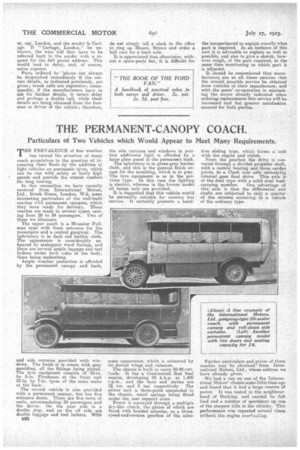THE PERMANENT-CANOPY COACH.
Page 12

If you've noticed an error in this article please click here to report it so we can fix it.
Particulars of Two Vehicles which Would Appear to Meet Many Requirements.
THE PREVALENCE of fine weather has turned the attention of many coach proprietors to the question of increasing their fleets.. by the addition of light vehicles on pneumatic tyres, which can' he run with safety at fairly high speeds and provide the utmoS‘t comfort _for long touring.
In this connection we. have recently received from International Motors, Ltd., Brook Green, London, W.6, some interesting particulars of the well-built coaches with permanent canopies, which they have ready for delivery. These coaches are made in several types seating from 20 to 24 passengers. Two of these we illustrate.
The upper coach is a 20-seater Pullman type with front entrance for the passengers and a central gangway. The upholstery is in dark red leather cloth. The appearance is considerably enhanced by mahogany wood facings, and there are several ample luggage and toot lookers under both sides of the body, these being underslung.
Ample weather protection is afforded by the permanent canopy and back, and side curtains provided with windows. The finish is in cre.am with grey moulding, all the fittings being plated. The tyre equipment consists of 35-in. by 5-in. Pirestones at the front and 38;in. by 7-in. tyres of the same make at the back.
The second vehicle is also provided with a permanent canopy, but has five entrance doors. There are five rows of seats, accommodating 24 passengers and the drives-. On the near side is a double step, and on the off side are double luggage and tool lockers. With
B2S the side curtains and windows in position additional light is afforded by a large glass panel in the permanent baek. The upholstery is in green-grey leather cloth, and this is the general finish except for the moulding, which is in grey. The tyre equipment is as in the previous type. In this case the Fighting is electric, whereas in the former model oil lamps only are provided.
It is suggested that this vehicle would be eminently suitable for country bus service. It certainly presents a hand
some appearance, which is enhanced by its domed wings and valances.
The ehasaists built to carry 30-40-c.wt. loads. It has a Continental Red Seal engine, developing 2.5 b.h.p. at 1,100 r.p.ra,, and the here and stroke are 3,1 ins. and 5 ins. respectively. The power unit is three-point suspended in the chassis, recoil springs being fitted under the rear support arms. Power is conveyed through a multiple dry-disc clutch, the plates of which are faced with bonded asbestos, to a threespeed-and-reverse gearbox of the melee
live sliding type, which forms a unit with the engine and clutch.
From the gearbox the drive is conveyed through a divided propeller shaft, with a central bearing and three carclan joints, to a Clark rear axle embodying internal gear final drive. This axle is of the dual type with a solid steel load
carrying member. One advantage of this aide is that the differential and shafts are subjected to only a quarter of the stresses occurring in a vehicle of the ordinary type.
Further particulars and prices of these coaches may be obtained' from International Motors, Ltd., whose address we have already given.
We had a run on orre of the International Motors' chassis some little time ago and found that it had a large reserve of power. It was tested in the neighbourhood of Dorking, and carried its full load and a number of spectators up one of the steepest hills in the vkinitv. This performance was repeated several times without the engine overheating.




























